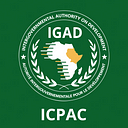By Fitih Ademe Mamo (Ph.D.), Soil science, Climate, and Crop modelling at Ethiopian Institute of Agricultural Research with contributions from the IGAD Climate Change Technical Working Group
Introduction to anthropogenic climate change
Global warming resulting from human activities is becoming a significant environmental challenge in the 21st century. After a thorough assessment of the causes of global temperature change, the Intergovernmental Panel on climate change (IPCC) concluded that there has been significant anthropogenic warming over the past 50 years on each continent except Antarctica.
Scientific evidence indicates that anthropogenic factors significantly contribute to global climate change. Atmospheric concentration of greenhouse gases (GHGs) such as carbon dioxide, methane, and nitrous oxide has substantially increased over time.
The National Oceanic and World Atmospheric Administration (NOAA), indicates that carbon dioxide concentration has risen from 280 ppm (pre-industrial level) to about 420.66 ppm in April 2022, a 50% increase due to human activities.
Regional Temperature Trends during 1981–2010
The annual average temperature records of the Ethiopian Rift Valley (ERV) showed a warming trend across 16 stations selected for analysis. The temperature trend averaged over stations showed a significant (P < 0.01) increase of 0.43 ºC per decade, from 0.27 ºC to 0.58 ºC. The trend, however, showed spatial variations within the Rift Valley.
The rate of increase up to +1.2 ºC per decade was observed in the northeastern lowlands of the ERV, whereas the southwestern escarpments did show a slight increase of +0.04 ºC per decade. The central part of the Rift Valley also showed an increased range of +0.27 to +0.7 ºC per decade.
Although the magnitude of the annual change rate varies across locations, the direction of the change was similar, indicating warming during the observational period.
Detection and attribution of Anthropogenic Signals in the Climate Records of the Region
The presence of anthropogenic signals in the temperature records of the ERV was assessed to detect the existence of human influence in observed warming. Global Climate Model (GCM) derived signal fingerprints of greenhouse gases (GHG) were strongly detected in the observed temperature records consistently by all GCMs during 1981–2010.
Consistency of the observed temperature trend with the time dependent evolution of GHG in the region lend evidence for detection of anthropogenic signals in the observed temperature.
Assessment of the causes of the observed regional warming also proved that anthropogenic signals (GHG) together with natural factor (Solar activity) significantly attributed to the observed warming and changes of the ERV climate trends.
The robust GHG signal detection, evidence on the anthropogenic emission of GHGs, and the natural forcing’s attribution for the unprecedented warming in the region, therefore, call for an urgent need to develop a solid mitigation action plan in the ERV region.
